10 Best Front Squat Alternatives for Home and Gym
Author:
Reviewed by:
(21 years of Oly Lifting experience)
Unlock your full potential by engaging with our experts and community! Have questions about your fitness journey or looking for expert advice on weightlifting techniques? Don’t hesitate — leave a comment below and Sergii Putsov will provide a personalized answer and insights to help you reach your goals.
Torokhtiy is reader-supported. Some links are affiliate links, and we may earn a commission at no extra cost to you. See our disclosure page for details.
Leg day wouldn’t be leg day without front squats. They’re excellent for building strength in your lower body and they promote functional fitness in general.
But getting that squat to be perfect takes a lot of work so people often look for front squat alternatives to make their lives easier.
You might be struggling with form, or you’re dealing with some kind of equipment limitations; whatever the case, you could probably benefit from a few alternatives. And about that – there’s not a few of them.
There are a whole bunch of exercises that are a super effective alternative to front squats, and we’ll teach you all about them. We’ll also touch on how to incorporate them into your training and sprinkle a few safety tips over the top.
If you’re here, then you’re looking to step away from the conventional and dive into this vast range of alternatives!
Let’s go!
What are the most common front squat alternatives? The most common alternatives to front squats are goblet squats, Bulgarian split squats, dumbbell front squats, and Zercher squats. They’re very effective for building strength in the lower body while still having all the benefits of the traditional front squat.
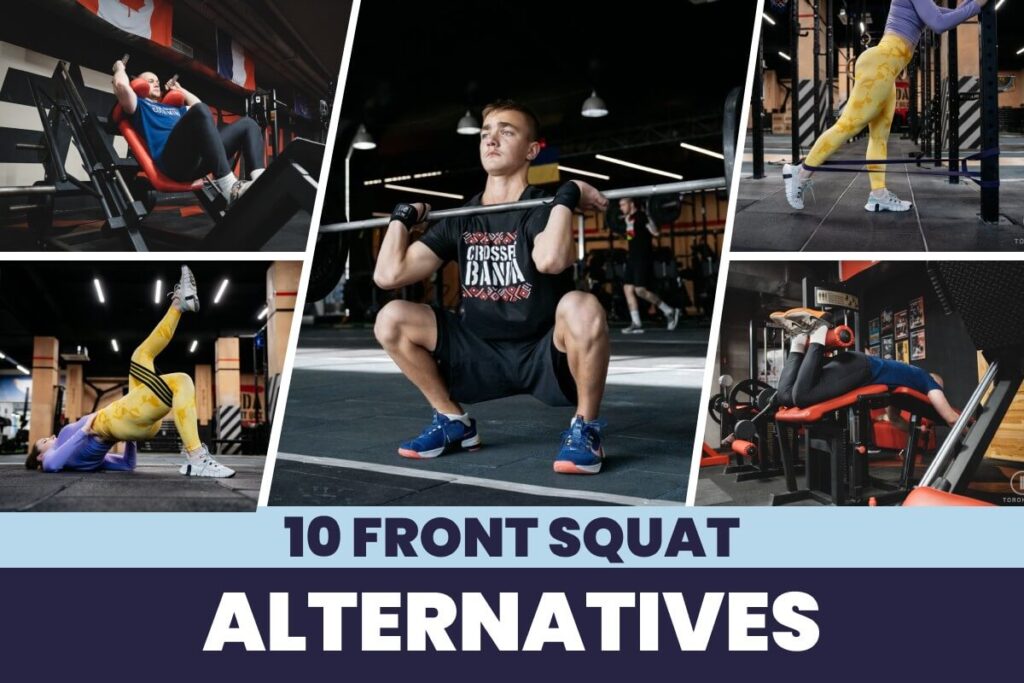
What Are Front Squats?
Front squats will put your body to the test, but they have a lot of benefits and that’s why we do them. This is a compound exercise that engages a lot of different muscle groups at the same time, like the quads, hamstrings, and glutes, not to mention the challenge it throws at your core and upper body for stability.
But it’s not just about the raw strength; front squats can improve your athletic performance because they mimic functional movements and improve overall coordination.
The thing about front squats is, they’re hard to do. You need to get deep enough for the squat to be fully effective, but some people struggle with mobility.
Then there’s the matter of equipment because not everyone has easy access to a barbell setup or the comfort level to dive into the deep end of the front squat territory. If you’re having problems with things like these, however, they don’t need to be roadblocks because there are ways of fixing them.
If you’re struggling with mobility, the easiest way to go about it is to do goblet squats or dumbbell front squats. This doesn’t mean you should stop trying to do the front squat, but these alternatives will be an easier entry point.
If you don’t have access to equipment, no biggie, do variations like Bulgarian split squats that need minimal equipment but they’re still extremely efficient. If your main issue is comfort (although… how comfortable do you expect to be during squats?), try to find some alternatives that feel better and work your way up to the traditional front squat.
You’ll find that, although front squats are difficult to do, they’re not impossible if you’re willing to take your time and work with what you currently have. We have alternatives for a reason, so no challenge is insurmountable.
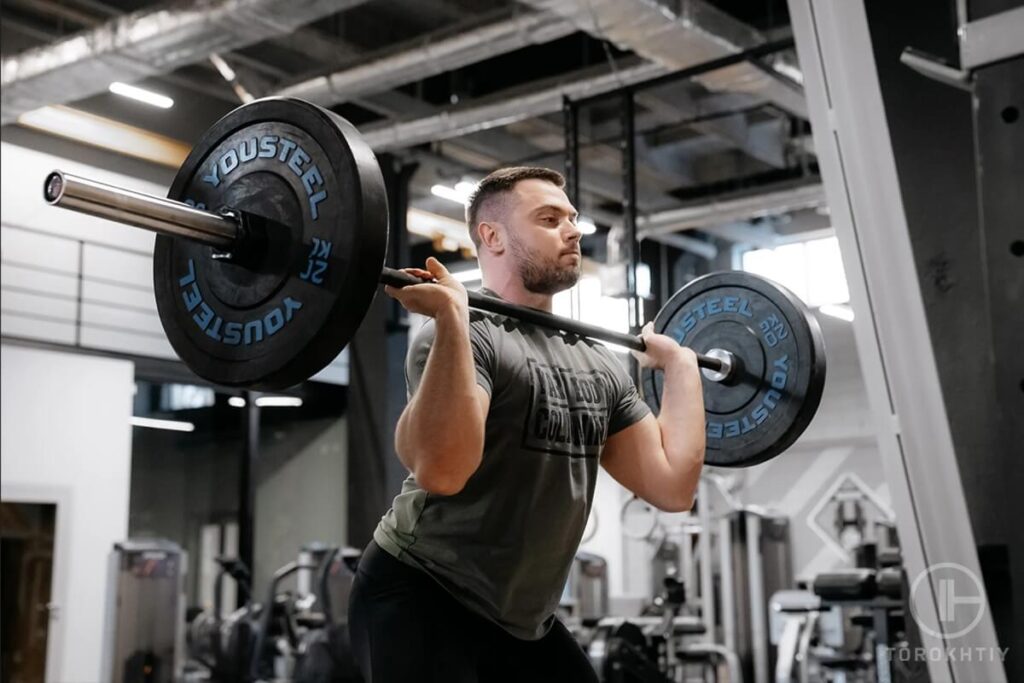
10 Best Front Squat Alternatives
We’ve gone through the basics, so we can now dive into the really interesting stuff – the actual alternatives (that’s why you’re here!). You came to find a proper front squat replacement, so let’s check out what you can do instead.
What exercise should you opt for if front squats aren’t really your best choice at the moment, or have become a bit stale/repetitive in your workout routine?
1. Goblet Squats (Dumbbell/Kettlebell)
This is one of the most common exercises people do when they haven’t quite mastered front squats. You’ll need a dumbbell or a kettlebell for this one, and you’ll hold it close to your chest with your torso being upright. Squat down and make sure your knees track over your toes.
Goblet squats will give you a great foundation for squat mechanics and they will engage your core and lower body. The anterior load will make it easier for you to stay upright and it will be gentler on your lower back. This exercise is more user-friendly than front squats are, so if you’re a beginner or you’re still trying to get the form down, goblet squats are ideal
2. Single-Arm Kettlebell Front Squats (Dumbbell/Kettlebell)
Hold a kettlebell in one hand in the front rack position and keep your core tight. Then, just squat. This alternative to front squat targets each of your legs independently, so it improves balance and stability. It will also need you to engage your core a bit more than you would with some other exercises because you need to resist rotation.
Single-arm kettlebell front squats mimic the traditional front squats’ unilateral challenge, but this variation adds an extra dimension of core activation and stability.
3. Pistol Squats (Calisthenics)
These might not be too beginner-friendly, but there are progressions and tweaks that can make them work for all fitness levels.
Balance on one leg and extend the other leg straight out, then squat down on the working leg while keeping your non-working leg off the ground. Pistol squats focus on unilateral strength, stability, and flexibility and they are excellent for people who want to work on their functional movements and improve their balance.
Tips From the Champ
If pistol squats are too challenging for you, you can start by practicing partial range-of-motion squats while holding onto something to support you (railing, the back of a chair, etc.). This will help you gradually build strength and balance. You can also do exercises that target hip and ankle mobility, like lunges and leg swings.
Olympic Weightlifting Champion
4. Step-Ups (Calisthenics)
Step-ups are a great way to prevent injuries and they can easily be modified to work for all fitness levels. If you’re a beginner, start with a lower platform, and if you want more challenge, you can include some additional resistance through dumbbells or a weighted vest. They isolate each leg, and they can address muscle imbalances, which often lead to injuries.
All you do is step onto a bench or platform with one leg, lift yourself up, and then lower back down. The controlled nature of this movement will improve proprioception and balance, but it will also engage multiple muscle groups, like your quads, hamstrings, glutes, and calve
5. Zercher Squats (Barbell/Machine)
This is another very common barbell front squat alternative for people who are trying to do something other than front squats. They give a unique challenge because they engage your upper back and core, but still target your lower body. If you’re struggling with the front rack position, Zercher squats will be an excellent alternative.
To do them, cradle a barbell in the crooks of your elbows and, keeping it close to your body, squat down with an upright posture. The loading pattern is comparable to the one of front squats, but there’s less strain on your wrists and shoulders.
6. Smith Machine Squats (Barbell/Machine)
The Smith machine will provide a controlled environment for squats and help with stability. This alternative is great for people who want the mechanics of the front squat, but without the need for extensive mobility or a free barbell. Although this is different from free-weight squats, Smith machine squats are a controlled alternative for those who have certain kinds of limitations or just want more stability.
You’ll use the Smith machine for stability, place the barbell across your front shoulders, and then squat. It sounds simple, but these are pretty challenging to do.
7. Safety bar Squats (Barbell/Machine)
These squats are easier on your shoulders and wrists, so they’re great for people who struggle with mobility or that experience discomfort in the front rack position. They will engage your core and lower body, especially the glutes.
You’ll need a specialized safety bar, and you’ll rest it on your shoulders. Keep your hands on the side handles, and then squat. This is a more comfortable way to target similar muscle groups as the front squat, but there’s no added stress on your upper body.
8. Bulgarian Split Squats (Unilateral)
Bulgarian split squats are extremely effective when it comes to handling muscle imbalances between the left and right legs. They challenge your balance and coordination, which means they’ll be great for anyone, but especially for people that have imbalances to address.
Step one foot onto a bench or platform, lower your back knees towards the ground, and then push back up. This exercise focuses on unilateral strength, stability, and flexibility.
9. Lunges (Unilateral)
You probably already know how to do lunges, but it doesn’t hurt to mention it just to be sure. You step forward, backward, or to the side, and you lower your body until both of your knees are bent at a 90-degree angle, and then you return to your starting position.
Lunges are very versatile, and they target various muscles. They promote functional movement patterns and improve balance, coordination, and unilateral strength. Like split squats, they also help take care of muscle imbalances because they work each leg independently, which contributes to symmetry.
10. Belt Squats (Specialized Equipment/Accessories)
Get a belt, load it with weight plates and attach it around your waist and then do squats.
The belt will reduce spinal loading, so this is an ideal front squat substitute if you have issues with your back or if you just want an alternative to traditional barbell squats. You’ll still get all the benefits of squatting, but with less stress on the spine.
| EXERCISE | TECHNIQUE | BENEFITS | WHY IT’S A GOOD ALTERNATIVE |
|---|---|---|---|
| Goblet squats | Hold a dumbbell or a kettlebell close to your chest, squat down and make sure your knees track over the toes | Foundation for great squat mechanics, engages core and lower body, gentler on the lower back | User-friendly, ideal for beginners or those that struggle with form |
| Single-arm kettlebell front squats | Hold a kettlebell in one hand in the front rack position, squat, engage core for unilateral strength and stability | Targets each leg independently, adds extra core activation and stability | Mimics front squats’ unilateral challenge but adds an extra core dimension |
| Pistol squats | Balance on one leg, extend the other straight out and squat down while keeping the non-working leg off the ground | Focuses on unilateral strength, stability, and flexibility | Great for functional movements and improving balance |
| Step-ups | Step on a bench or platform with one leg, lift your body, then lower it | Prevents injuries, isolates each leg, addresses muscle imbalances | Great for all fitness levels, engages multiple muscle groups |
| Zercher squats | Cradle a barbell in the crooks of your elbows, squat down with an upright posture | Engages upper back and core, targets lower body with less strain on the wrists and shoulders | Great for people who struggle with the front rack position |
| Smith machine squats | Use the Smith machine for stability, place the barbell across the front shoulders and squat | Provides a controlled environment for squats, helps stability | Alternative for front squat mechanics with controlled stability |
| Bulgarian split squats | Step one foot onto a bench or platform, lower the back knee toward the ground, and push back up | Addresses muscle imbalances, challenges balance and coordination | Effective for unilateral strength, stability, and flexibility |
| Lunges | Step forward, back, or to the side and lower your body until both knees are at a 90-degree angle, then return to the starting position | Versatile, targets various muscles, promotes functional movement patterns | Improves balance, coordination, and unilateral strength |
| Safety bar squats | Rest a safety bar on the shoulders, keep hands on the side of the handles and squat | Easier on the shoulders and wrists, engages core and lower body | Ideal for mobility issues or if you experience discomfort in the front rack position |
| Belt squats | Load a belt with weight plates, attach it around the waist and squat | Reduces spinal loading, easier on your back and spine | Has squat benefits without the added stress on the spine |
How to Include Front Squat Alternatives into Your Training?
If you want to include front squat variations in your training routine, you’ll need to do it strategically. The first thing to do is to get clear on your goals. Ask yourself what do you want from this – improve your strength, better muscle endurance, or if you just want to improve your overall functional fitness. Once you know what you’re aiming for, it will be easier to choose the exercises.
Follow us!

Free!
Get a 2-week Weightlifting Program as a bonus for the subscription to kickstart your training plan!

Free!
Let’s say you’ve realized what it is you’re going after and now you know what to do. You want your training routine to stay balanced, so you should spread out the exercises throughout the week.
For example, if you’ve chosen pistol squats, step-ups, and lunges, you can do each of them on a different day to make sure each gets enough attention. You also need to consider the volume. If you’re a beginner, start with 2-3 sets of 8-12 reps and then increase that as your strength improves.
If you’re after hypertrophy, 3-5 sets of 8-12 reps will do the trick.
Another really important thing is progressive overload. If you’re a beginner, you probably heard of this term before, but you might not understand just how important this is. This means that you increase the intensity little by little, as your strength and technique improve, and this way, you make sure that your muscles develop, you don’t hit plateaus, and you’re at less risk of injury.
You can increase the intensity by adding more weight, increasing the difficulty of the exercise, or doing variations – the point is, you want to keep challenging yourself. You should also track your progress, even without the front squat as a benchmark. Document things like the amount of weight you lifted, how difficult your exercises were, or how deep you managed to squat.
This gives you a tangible record of your progress, but it will also clearly show which areas need to be improved.
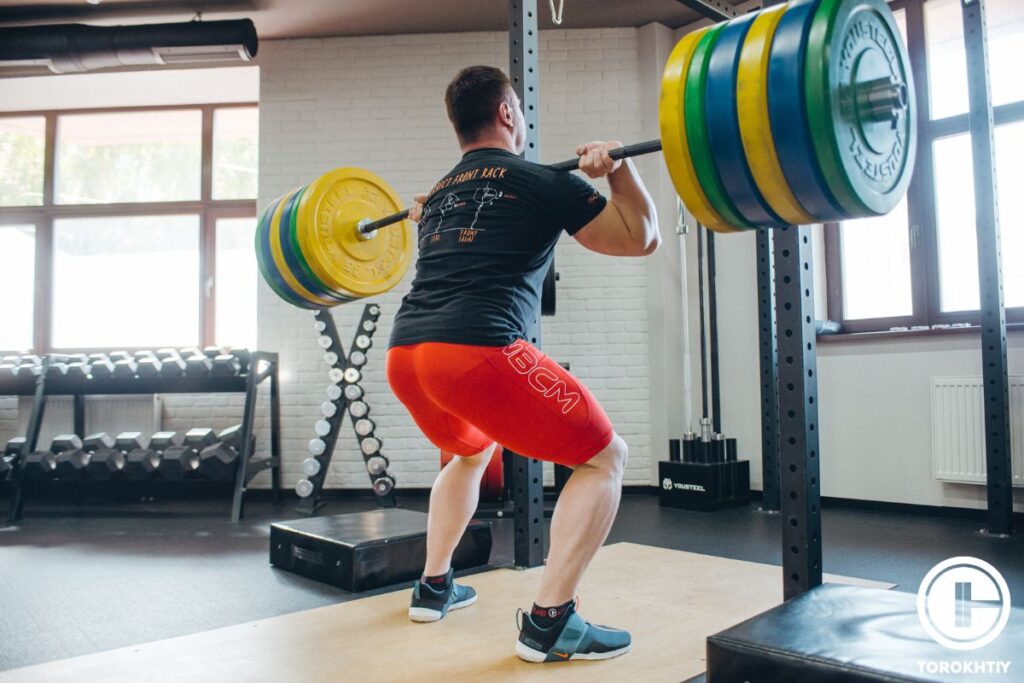
If you end up working out for a certain amount of time and your routine doesn’t change, it will become monotonous, so rotate between different exercises. This keeps things fresh but also lets you target various muscle groups, so your routine is more well-rounded.
Of course, you need to pay attention to your body’s signals and see how it responds to each exercise. If one of them causes too much discomfort, you can either modify it or skip it altogether and try it out later, when your strength improves.
And don’t forget that an effective training plan needs rest and recovery. Give your body enough time to rest because your muscles need time to repair in order to grow.
Include some rest days in your routine, and consider deloading phases for optimal recovery. Overtraining won’t do you any good, it will just put a damper on your progress and increase the risk of injury.
Tips From the Champ
You can make front squat alternatives even more effective if you include functional movement patterns in your training. For example, do goblet squats with overhead presses or step-ups with bicep curls. This way, you’ll target multiple muscle groups at the same time and improve coordination and functional strength.
Olympic Weightlifting Champion
5 Safety Tips
It’s great to be enthusiastic about your fitness journey, especially when you’re about to incorporate some new exercises into your routine. But safety should always come first, so let’s see how to prevent those pesky strains, sprains, and everything else that can go wrong.
1. Correct Form
When your form is correct, you get the most out of your workout, but more importantly, you’re at less risk of injury. Whichever exercise you do, keep your spine neutral, engage your core, and make sure your knees track over your toes.
Tips From the Champ
Pay attention to how you place your feet. Proper alignment starts from the ground up, regardless of the exercise you’re doing. Keep your feet securely planted so the weight is distributed evenly. This will make you more stable and prevent unnecessary stress on your joints.
Olympic Weightlifting Champion
2. Warm-Up
You shouldn’t start working out if you haven’t warmed up first. A good warm-up is your best friend when it comes to preventing injuries and improving performance. Take 10-15 minutes to do leg swings, hip circles, or bodyweight squats before you get into something more intense.
3. Be Careful with the Range of Motion
Of course you want to get to that depth in squats, and that’s commendable, but don’t force yourself into crazy ranges of motion before you’re ready for it because it won’t do you any good. Best case scenario is, you’ll end up feeling discomfort. Worst case scenario?
You’ll get injured and you’ll need to wait until you recover before you’re ready to work out again. Work within a comfortable range and expand it as you become more flexible.
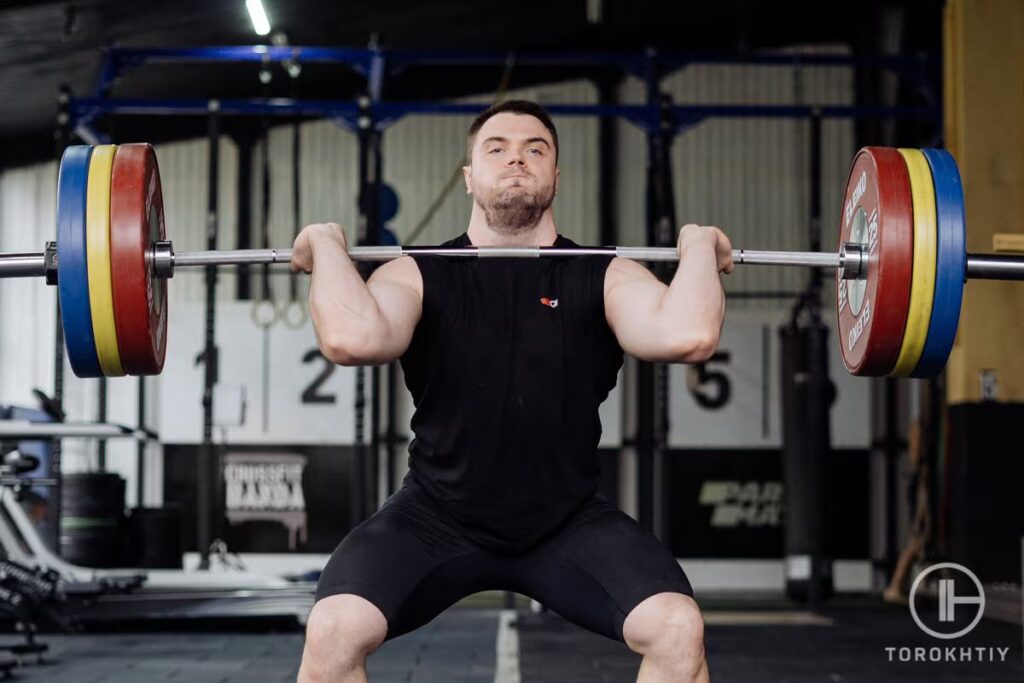
4. Get Familiar with the Equipment
If you’re using specialized equipment or machines, take the time to get acquainted with how to use them properly. When you fully understand your equipment, your workouts are more effective and there is less risk of accidents.
5. Cool Down
When you’re done working out, take a few minutes to cool down. It’s just as important as warming up because it lets your heart rate return to normal and it promotes flexibility. A few minutes of static stretches, holding each of them for 15 to 30 seconds, will be enough to cool down properly.
🔻GET A FREE PROGRAM DEMO: 12 Week Squat Program by Oleksiy Torokhtiy
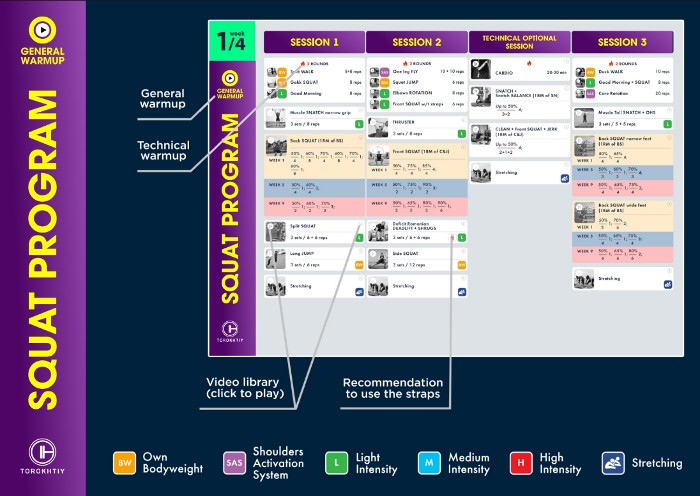
Do you want to double your squat strength? In just 12 weeks, you’ll be able to boost your squat results.
Enter your details and get a free demo (1 free week) of the squat program straight into your inbox.
FAQ
Can leg press replace front squat?
It can be a good alternative, but it’s not a substitute for front squats. The leg press will engage your quads, hamstrings, and glutes, just like the front squat does, but it won’t give you the same level of core stability and balance challenge. Still, the leg press can be a great addition to your lower body training.
What machine is equivalent to the front squat?
There are more than one. The Smith Machine and the Hack Squat Machine would be the most common choices. The Smith Machine will be the more beginner-friendly option to more easily learn the mechanics of the exercise, while the hack squat machine will be excellent if you’re looking to isolate your quads while still working your hamstrings and glutes.
Conclusion
If you came here looking for alternatives to front squats, you’ve now found them. And not one, but a dozen to choose from and diversify your workout routine. Regardless of whether you’re struggling with front squats, or are simply tired of the repetitiveness, you’ll now easily be able to mix things up a little!
Whichever one of the ten recommended alternatives you go for, be sure to pay close attention to your form. Don’t overload with the weight; progress forward in small digestible increments. This will ensure safety, and better form and ensure better control over your body.
What we’d love to do is – hear from you! What are your front squat alternatives? Do you have some that weren’t included on our list? Were you surprised by some of the entries? Whichever the situation, if you have questions, you have suggestions, or even some nifty tips & tricks, be sure to keep squatting, keep working, and keep those comments coming. Because we’d love to hear what you think.
Stay consistent, and enjoy!
Also read:
- 24 Best Squat Alternatives For Different Needs
- 14 Best Back Squat Alternatives Trainers Recommend
- Do Squats Work Abs? Variations & 5 Alternatives
- 12 Exercises To Improve Squat Strength & Form
- Butt Wink Causes & Fixes For Perfect Squat Form
- Best Squat Warm-Up For Peak Performance
- Safety Bar Squats: Form & Benefits Explained
References:
- Becks Shepherd “Why are rest days important?,” LiveScience, https://www.livescience.com/why-are-rest-days-important (accessed March 12th, 2024)
- Eirik Kristiansen, Stian Larsen, Markus E Haugen, Eric Helms, Roland van den Tillaar “A Biomechanical Comparison of the Safety-Bar, High-Bar and Low-Bar Squat around the Sticking Region among Recreationally Resistance-Trained Men and Women,” International Journal of Environmental Research and Public Health 18, no. 16 (2021): 8351.
- Health Promotion Board (HPB) “Prevent Injuries with Proper Form During Workouts,” Singapore University Health Center, https://www.nus.edu.sg/uhc/articles/details/prevent-injuries-with-proper-form-during-workouts (accessed March 12th, 2024)
- Lindsay V. Slater, Joseph M Hart “Muscle Activation Patterns During Different Squat Techniques,” J Strength Cond Res 31, no. 3 (2017): 667-676.
- Tim Bishop “Stronger Legs and Lower Body,” Human Kinetics, https://us.humankinetics.com/blogs/excerpt/proper-form-and-technique (accessed March 12th, 2024)
- All photos are made by our Torokhtiy Media Team
Why Trust Us?
With over 20 years in Olympic weightlifting, strength training, nutrition coaching, and general fitness our team does its best to provide the audience with ultimate support and meet the needs and requirements of advanced athletes and professional lifters, as well as people who strive to open new opportunities and develop their physical capabilities with us.
By trusting the recommendations of our certified experts in coaching, nutrition, and sports training programming, as well as scientific consultants, and physiotherapists, we provide you with thorough, well-considered, and scientifically proven content. All the information given in the articles concerning workout programming, separate exercises, and athletic performance, in general, is based on verified data.
The product testing process is described in more detail here.
Author: Sergii Putsov
Head of Sport Science, PhD
Best Results: Snatch – 165 kg,
C&J – 200 kg
Sergii Putsov, Ph.D., is a former professional weightlifter and National team member, achieving multiple medals in the 94 kg weight category at national competitions. With a Master’s degree in “Olympic & Professional Sport Training” and a Sport Science Ph.D. from the International Olympic Academy, Greece, Sergii now leads as the Head of Sport Science. He specializes in designing training programs, writing insightful blog articles, providing live commentary at international weightlifting events, and conducting educational seminars worldwide alongside Olympic weightlifting expert Oleksiy Torokhtiy.
Reviewed by: Oleksiy Torokhtiy
Olympic Weightlifting Champion, PhD in Sport Science
Best Results: Snatch – 200 kg,
C&J – 240 kg
Oleksiy Torokhtiy is a professional athlete boasting 20 years of experience in Olympic weightlifting. With multiple European and World titles under his belt, he has showcased his prowess in two Olympic Games (Beijing 2008 and London 2012). Upon concluding his illustrious career, Oleksiy dedicated himself to coaching. By 2022, he had conducted over 200 weightlifting seminars worldwide. He is the visionary behind an international sportswear and accessories brand known for its motto, “Warm Body Cold Mind.” Additionally, he is an esteemed author and the creator of a series of training programs and eBooks.





Still have questions after reading our article? Unlock your full potential by engaging with our experts and community! Don’t hesitate — leave a comment below and Sergii Putsov will provide a personalized answer and insights to help you reach your goals.